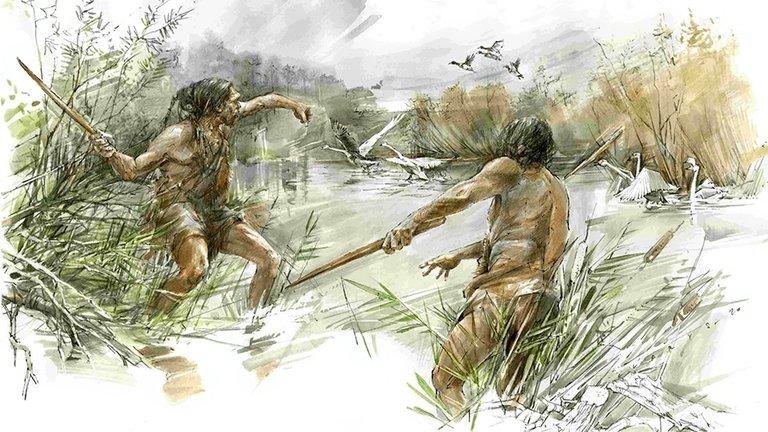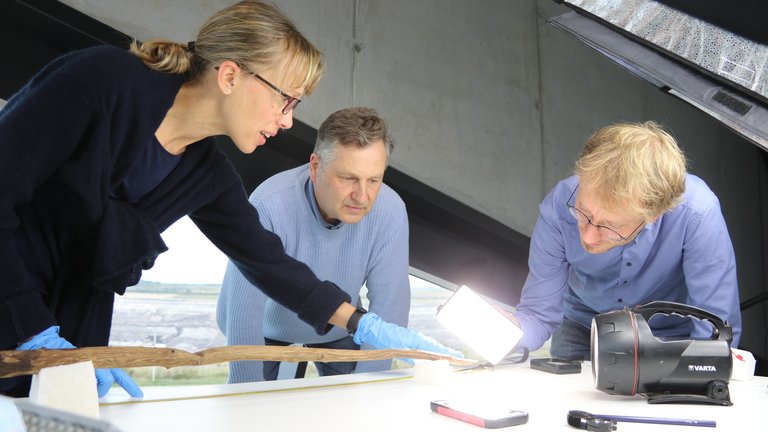News
Research Impact: early humans used expert woodworking skills to make sophisticated hunting weapons, British Academy Postdoctoral Fellow finds
6 Sep 2023

Research funded by the British Academy has revealed that early humans’ woodworking techniques were far more advanced than previously thought and allowed them to make sophisticated hunting weapons.
Led by experimental archaeologist Dr Annemieke Milks (University of Reading) and supported by the British Academy and the German Research Foundation, a team of researchers analysed a 300,000-year-old wooden stick using state-of-the-art imaging techniques such as 3-D microscopy and micro-CT scans. The 77cm-long stick was one of several different tools discovered in 1994 in Schöningen, a region in Germany that was submerged in water for most of the intervening time protecting the wooden artefacts from bacteria and fungi. The site has yielded the earliest large-scale record of wooden tools made by humans, opening the doors to new discoveries and insights.
The research team’s analysis suggests that the weapon, fashioned from the branch of a spruce tree, was scraped, seasoned and sanded before use and may have been designed to be thrown like a boomerang to stun medium-sized animals like deer. It demonstrates, for the first time, that Middle Pleistocene humans had the ability to plan well in advance and had strong knowledge of the properties of wood.
The findings, published in the PLOS ONE journal, also suggest that the use of lightweight throwing sticks during hunts could have involved the entire community, including as a learning tool for children.
Dr Milks’ study sets a new standard for analysing wooden tools, which had not previously been systematically analysed in the same way bone or stone tools have been.
Dr Annemieke Milks said:
“Having the opportunity to handle and understand the earliest weapons, shaped from spruce 300,000 years ago using simple stone tools, has been a very privileged experience. The interdisciplinary nature of the teamwork meant we all learnt new things from one another, as well as from this special object.
“Although early woodworking may sound quite simple, the sophistication of the multiple steps involved, as well as intentionally designing a weapon capable of flight, really shows us how clever these early humans were. The study is the first of its kind to be able to clearly detail how the earliest woodworking was undertaken.
“When we think about the deep past, we can sometimes fail to envision what whole societies looked like, so it was interesting to consider how similar tools were used by children in more recent societies. Although we can’t know for certain whether or not kids used such tools for hunting, engaging in this possibility really helped bring the past alive for us.”
Dr Milks was awarded a Postdoctoral Fellowship by The British Academy in 2021 and her research project ‘Reverse Engineering Pleistocene Spears: Interdisciplinary Perspectives on Raw Materials and Performance’ has been highlighted in the national and regional media including in the BBC, The Independent, the New Scientist and the Evening Standard.
Postdoctoral Fellowships are three-year awards given to outstanding early career researchers in the SHAPE disciplines who wish to pursue an independent research project. They are designed to strengthen award-holders experience of research and teaching in an academic environment.
The interdisciplinary nature of Dr Milks’ research, which utilises 3-D microscopy, micro-CT scans and 3-D models, emphasises the rewards and impact of Connected Knowledge in SHAPE research.
